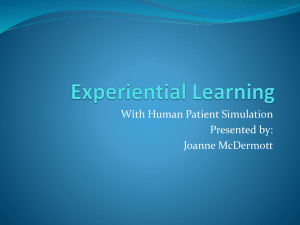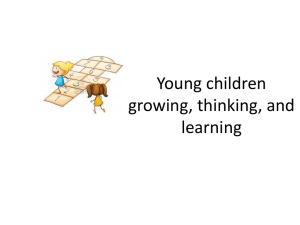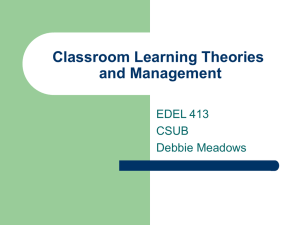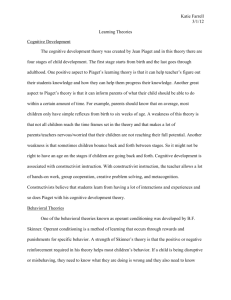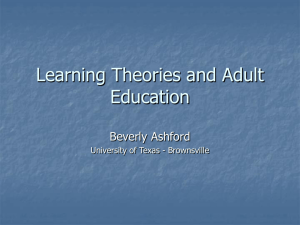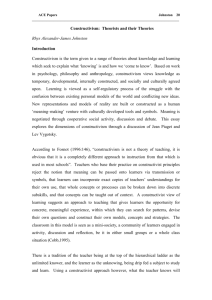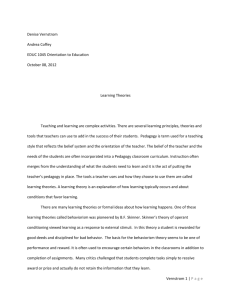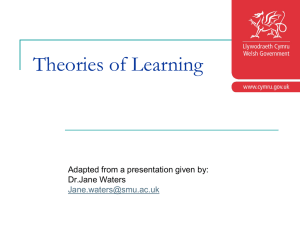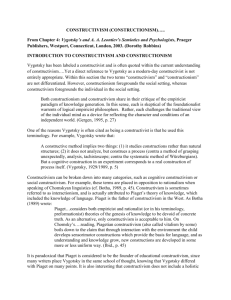CONSTRUCTIVISM in Piaget and Vygotsky
advertisement
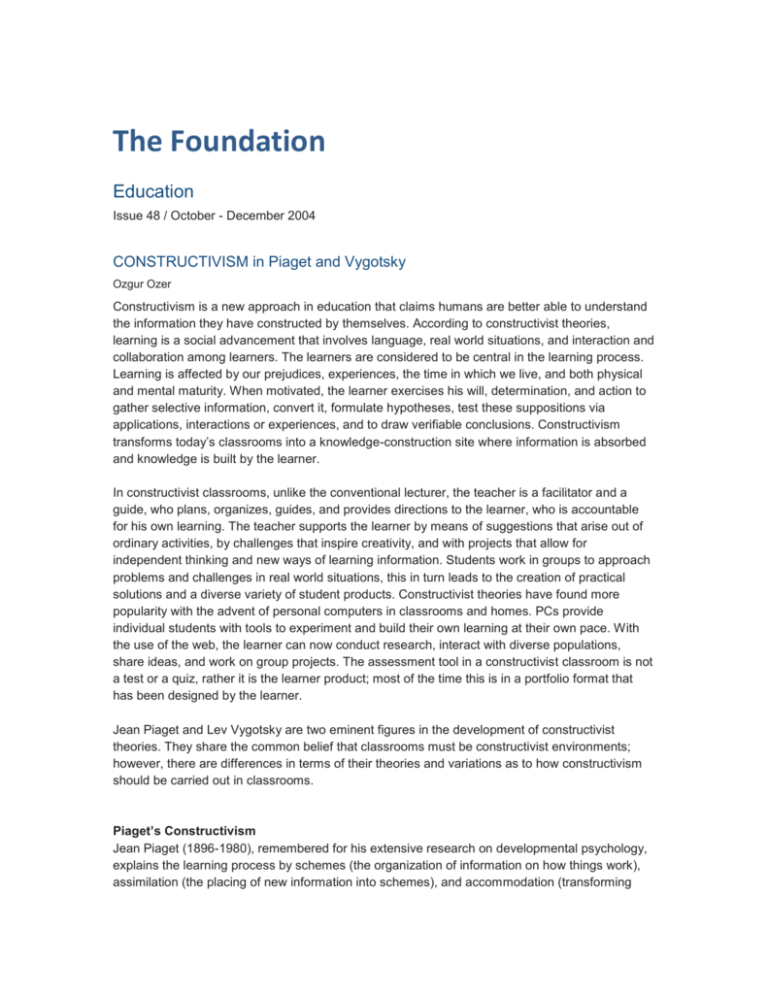
The Foundation Education Issue 48 / October - December 2004 CONSTRUCTIVISM in Piaget and Vygotsky Ozgur Ozer Constructivism is a new approach in education that claims humans are better able to understand the information they have constructed by themselves. According to constructivist theories, learning is a social advancement that involves language, real world situations, and interaction and collaboration among learners. The learners are considered to be central in the learning process. Learning is affected by our prejudices, experiences, the time in which we live, and both physical and mental maturity. When motivated, the learner exercises his will, determination, and action to gather selective information, convert it, formulate hypotheses, test these suppositions via applications, interactions or experiences, and to draw verifiable conclusions. Constructivism transforms today’s classrooms into a knowledge-construction site where information is absorbed and knowledge is built by the learner. In constructivist classrooms, unlike the conventional lecturer, the teacher is a facilitator and a guide, who plans, organizes, guides, and provides directions to the learner, who is accountable for his own learning. The teacher supports the learner by means of suggestions that arise out of ordinary activities, by challenges that inspire creativity, and with projects that allow for independent thinking and new ways of learning information. Students work in groups to approach problems and challenges in real world situations, this in turn leads to the creation of practical solutions and a diverse variety of student products. Constructivist theories have found more popularity with the advent of personal computers in classrooms and homes. PCs provide individual students with tools to experiment and build their own learning at their own pace. With the use of the web, the learner can now conduct research, interact with diverse populations, share ideas, and work on group projects. The assessment tool in a constructivist classroom is not a test or a quiz, rather it is the learner product; most of the time this is in a portfolio format that has been designed by the learner. Jean Piaget and Lev Vygotsky are two eminent figures in the development of constructivist theories. They share the common belief that classrooms must be constructivist environments; however, there are differences in terms of their theories and variations as to how constructivism should be carried out in classrooms. Piaget’s Constructivism Jean Piaget (1896-1980), remembered for his extensive research on developmental psychology, explains the learning process by schemes (the organization of information on how things work), assimilation (the placing of new information into schemes), and accommodation (transforming existing schemes or creating new ones). The motivation for learning is the predisposition of the learner to adapt to his environment, hence to institute equilibrium between schemes and the environment. Continuous interactions among existing schemes, assimilation, accommodation, and equilibrium create new learning. Piaget explores four sequential stages of the psychological development of the young learner and believes teachers should be cognizant of these stages. During the Sensory-motor Stage, (before the age of 2) sensory experiences and motor activities dominate. Intelligence is intuitive in nature and knowledge; it is acquired through mental representation during the Preoperational Stage (from age 2 to age 7). At the Concrete Operational Stage (from age 7 to age 11), intelligence is logical, conserved, and dependent on concrete references. The Formal Operational Stage (after 11 years of age) is the stage when abstract thinking starts and the learner starts thinking about probabilities, associations, and analogies. Piaget’s developmental theory of learning and constructivism are based on discovery. According to his constructivist theory, in order to provide an ideal learning environment, children should be allowed to construct knowledge that is meaningful for them. The Piagetian Classroom Piaget believes that a constructivist classroom must provide a variety of activities to challenge students to accept individual differences, increase their readiness to learn, discover new ideas, and construct their own knowledge. Videodisks, CD-ROMs and simulation software enhance learning, while telecommunication tools, like e-mail and the Internet, provide contexts for dialogue and interaction within the classroom, the schools, and the community leading to the social construction of knowledge. Students have the opportunity to be exposed to other ideas, cultures, and forums on global issues. Students can work on collaborative projects, which may come in the form of a networked writing project, or the building of separate phases of an engineering project that enables them to receive and give instant responses. In an elementary Piagetian classroom, concrete learning experiences, such as drawing, drama, model building and field trips that involve hands-on opportunities to see, hear, touch, taste, and smell are essential. These early activities and the use of tangible manipulatives and visual aids serve as building blocks for more sophisticated tasks, such as reading comprehension. Vygotsky’s Constructivism Lev Vygotsky (1896-1934), known for his theory of social constructivism, believes that learning and development is a collaborative activity and that children are cognitively developed in the context of socialization and education. The perceptual, attention, and memory capacities of children are transformed by vital cognitive tools provided by culture, such as history, social context, traditions, language, and religion. For learning to occur, the child first makes contact with the social environment on an interpersonal level and then internalizes this experience. The earlier notions and new experiences influence the child, who then constructs new ideas. Vygotsky’s (1978, p. 56) example of being able to point a finger displays how this behavior, which begins as a simple motion, becomes a meaningful movement when others react to the gesture. Vygotsky’s constructivism is known as social constructivism because of the significance of culture and social context. For Vygotsky, the zone of proximal development “. . . the distance between the actual development of a child as determined by the independent problem solving, and the level of potential development as determined through problem solving under adult guidance or in collaboration with more peers (Vygotsky: 1978)” suggests that cognitive development is limited to a certain range at a particular age. However, with the help of social interaction, such as assistance from a mentor, students can comprehend concepts and schemes that they cannot know on their own. Curriculum specialists and lesson plan builders can use the zone of proximal development as a guiding reference. The Vygotskian Classroom A Vygotskian classroom emphasizes creating one’s own concepts and making knowledge one’s property; this requires that school learning takes place in a meaningful context, alongside the learning that occurs in the real world. As seen earlier in the Piagetian classroom, this model also promotes the active participation and collaboration of distinctive learners. The Vygotskian classroom stresses assisted discovery through teacher-student and student-student interaction. Some of the cognitive strategies that group members bring into the classroom are questioning, predicting, summarizing, and clarifying. In a Vygotskian classroom, dynamic support and considerate guidance are provided based on the learner’s needs, but no will or force is dictated. Students are exposed to discussions, research collaborations, electronic information resources, and project groups that work on problem analysis. Some examples of classroom activities that might be used in a constructive classroom are as follows: Students in a political science class can use a computer simulation to decide on global issues as representatives of United Nations. A geography class studying Turkey can take a virtual trip of tourist and historical sites and parks. The journalism class may publish a newsletter with scanned photographs, excerpts from the press and charts about a recent journey to space. As a final project, a sixth-grade history teacher may assign her students multimedia presentations of civilizations that prospered in Southern America. An aquatic science class could observe data on city water quality and communicate with students in other schools. The multiculturalism class students can build online genograms (family trees), and subscribe to genogram databases in search for relatives and the origin of their roots. Conclusion Both Piaget and Vygotsky appreciated the essence of building constructs and internalizing the knowledge given, rather than accepting the information as presented through rote-memory. Constructivist learning environments promote the learner to gather, filter, analyze, and reflect on the information provided and to comment on this knowledge so that it will result in individualized comprehension and private learning. This type of group learning will reduce the dissemination of false data, prejudice, and atrocities among diverse groups and help build a moral, scientific, information society in the new millennium. Be it developmental or social as suggested by Piaget and Vygotsky respectively, learning is the central activity for humans in search for understanding the causes and effects of natural phenomena, the progress of social events, and the meaning of life. By using such learning approaches we can better introduce our children to the world that God has created for us, and lead them to think about the miracles that are all around us.
